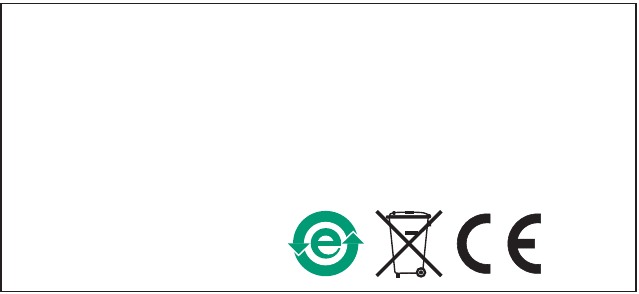Tait TPEHGD Two Way Radio User Manual TP9310 User s Guide
Tait Limited Two Way Radio TP9310 User s Guide
Tait >
User Manual Rev
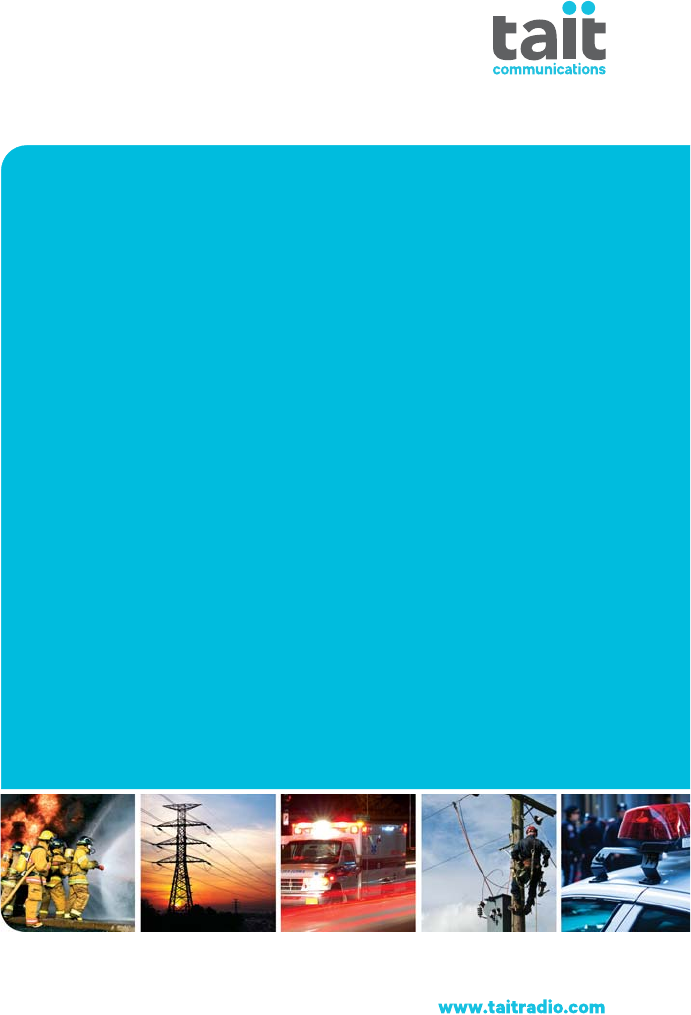
5BJUDMR Conventional and
Analog Portable Radios
User’s Guide
MPE-00001-01 · Issue 1 · September 2017
66TFS(VJEF$SPTT3FGFSFODF
&MTFXIFSFJOUIJTNBOVBMUIJTJTSFGFSSFEUPBT51
XJUIBEEFE(14BOE#5GVODUJPOBMJUZ
&MTFXIFSFJOUITNBOVBMUIJTJTSFGFSSFEUPBT51
T03-00302-GCAA/GBAA/GAAA "OBMPHBOE%.35SBEJP
T03-00303-GCAA/GBAA/GAAA:Same as T03-00302-GCAA/GBAA/GAAA
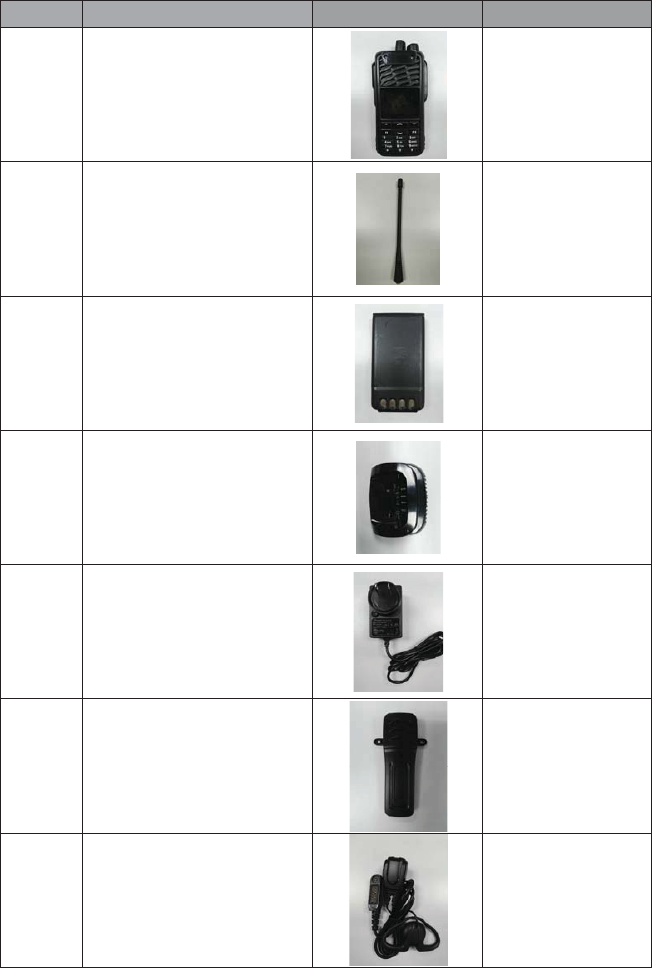
Package List
AccessoriesPhotoQuantity
1Radio
1
2Antenna
1
3Battery
1
4Charger
1
5Power Adapter
1
6Belt Clip
1
7 Headset
1
Contents 3
Contents
For your safety..................................................................7
Menu map........................................................................20
1 About this guide .............................................................21
Safety warnings used in this guide ........................................... 21
Related documentation............................................................. 22
2Before using your radio.................................................23
For your safety — battery warning ............................................. 24
Attaching labels to the radio or battery ..................................... 24
Charging the battery before first use ........................................ 25
Attaching the battery................................................................. 26
Removing the battery ............................................................... 26
Attaching the antenna............................................................... 27
Removing the antenna ............................................................. 27
Attaching an audio accessory................................................... 28
3Getting started................................................................29
About your DMR digital radio.................................................... 30
About the radio controls............................................................ 32
Understanding the radio display ............................................... 34
Understanding the radio indicators........................................... 36
Using function keys to access frequently used features........... 38
Navigating the radio’s menus ................................................... 39
4Operation.........................................................................40
Turning the radio on and off ..................................................... 41
Adjusting the speaker volume .................................................. 42
Connecting to a Bluetooth® device (TP3350 only) ................... 43
Selecting a zone ....................................................................... 45
Selecting a channel .................................................................. 45
Making a group call .................................................................. 46
Making a private call................................................................. 47
Turning scanning on and off ..................................................... 47
Making a call alert..................................................................... 48
Sending a quick text message.................................................. 49
Sending an emergency alarm................................................... 51
Turning location information on and off (TP3350 only)............. 52
5Charging and caring for batteries.................................53
About the chargers ................................................................... 54
6-way charger safety information ............................................. 54
Before using the charger .......................................................... 54
4 Contents
Charging temperatures............................................................. 55
Leaving the battery on charge .................................................. 56
Receiving calls while charging.................................................. 56
Low battery warning ................................................................. 56
Charging a battery for the first time .......................................... 57
Charging a battery .................................................................... 57
LED behavior............................................................................ 58
Removing the battery from the charger .................................... 59
Maintaining battery life and performance ................................. 59
Storing batteries ....................................................................... 59
Disposing of batteries ............................................................... 60
6Troubleshooting .............................................................61
About troubleshooting............................................................... 62
When your radio won’t turn on.................................................. 62
Identifying the radio’s audible tones ......................................... 62
Viewing radio information ......................................................... 62
General care............................................................................. 63
Tait Software Licence Agreement.................................63
Simplified Declaration of Conformity ...........................71
5
Copyright and trademarks
All information contained in this document is the property of
Tait Limited. All rights reserved. This document may not, in
whole or in part, be copied, photocopied, reproduced,
translated, stored, or reduced to any electronic medium or
machine-readable form, without prior written permission from
Tait Limited.
The word TAIT and the TAIT logo are trademarks of Tait
Limited.
All trade names referenced are the service mark, trademark
or registered trademark of the respective manufacturers.
Disclaimer
There are no warranties extended or granted by this
document. Tait Limited accepts no responsibility for damage
arising from use of the information contained in the document
or of the equipment and software it describes. It is the
responsibility of the user to ensure that use of such
information, equipment and software complies with the laws,
rules and regulations of the applicable jurisdictions.
Enquiries and comments
If you have any enquiries regarding this document, or any
comments, suggestions and notifications of errors, please
contact your regional Tait office.
Updates of manual and equipment
In the interests of improving the performance, reliability or
servicing of the equipment, Tait Limited reserves the right to
update the equipment or this document or both without
prior notice.
Intellectual property rights
This product may be protected by one or more patents or
designs of Tait Limited together with their international
equivalents, pending patent or design applications, and
registered trade marks: NZ 409837, NZ 409838, NZ 415277,
NZ 415278, NZ 530819, NZ 534475, NZ 547713, NZ 577009,
NZ 579051, NZ 579364, NZ 586889, NZ 610563, NZ 615954,
NZ 700387, NZ 708662, NZ 710766, NZ 711325 , NZ 726313,
NZ593887, AU 2015215962, AU 339127, AU 339391,
AU2016259281, AU2016902579, EU 000915475-0001,
EU 000915475-0002, GB 2532863, US 14/834609 Div. no 1,
US 15/346518 Div.no 2, US 15/350332, US 15/387026 Div.,
US 20150085799, US 20160044572, US 20160057051,

6
US 640974, US 640977, US 698339, US 702666, US 7758996,
US 8902804, US 9107231, US 9504034, US 9559967.
This product may also be made under license under one or
more of the following patents:
- US7203207, AU2004246135, CA2527142, GB2418107,
HK1082608, MY134526, US8306071
- US7339917, AU2004246136, CA2526926, GB2418812,
MY134217
- US7499441, AU2005262626, CA2570441, GB2430333,
JP4690397, NZ551231, KR100869043, RU2351080,
BRP10512052, MXPA06015241
- US 7200129, AU2005226531, CA2558551, CN1930809,
GB2429378, JP4351720, BRP10508671, NZ549124,
KR848483, RU2321952
The AMBE+2™ voice coding Technology embodied in this
product is protected by intellectual property rights including
patent rights, copyrights and trade secrets of Digital Voice
Systems, Inc. This voice coding Technology is licensed solely
for use within this Communications Equipment. The user of
this Technology is explicitly prohibited from attempting to
decompile, reverse engineer, or disassemble the Object
Code, or in any other way convert the Object Code into a
human-readable form.
The Bluetooth® word mark and logos are registered
trademarks owned by Bluetooth SIG, Inc, and any use of
such marks by Tait Limited is under licence. Other
trademarks and trade names are those of their respective
owners.
Environmental responsibilities
Tait Limited is an environmentally responsible company
which supports waste minimization, material recovery and
restrictions in the use of hazardous materials.
The European Union’s Waste Electrical and Electronic
Equipment (WEEE) Directive requires that this product be
disposed of separately from the general waste stream when
its service life is over. For more information about how to
dispose of your unwanted Tait product, visit the Tait WEEE
website at
www.taitradio.com/weee
. Please be
environmentally responsible and dispose through the original
supplier, or contact Tait Limited.
Tait Limited also complies with the Restriction of the Use of
Certain Hazardous Substances in Electrical and Electronic
Equipment (RoHS) Directive in the European Union.
In China, we comply with the Measures for Administration of
the Pollution Control of Electronic Information Products. We
will comply with environmental requirements in other markets
as they are introduced.

For your safety 7
For your safety
Before using your radio, please read the following
important safety and compliance information.
Radio frequency exposure information
For your own safety and to ensure you comply with the
radio frequency (RF) exposure guidelines of the
United States Federal Communication Commission’s
(FCC), Industry Canada, and those from other
administrations, please read the following information
before using this radio.
Using this radio
You should use this radio only for work-related
purposes (it is not authorized for any other use) and if
you are fully aware of, and can exercise control over,
your exposure to RF energy. To prevent exceeding
FCC RF exposure limits, you must control the amount
and duration of RF that you and other people are
exposed to.
It is also important that you:
■Do not remove the RF Exposure label from
the radio.
■Ensure this RF exposure information accompa-
nies the radio when it is transferred to other users.
■Do not use the radio if you do not adhere to the
guidelines on controlling your exposure to RF.
Controlling your exposure to RF energy
This radio emits radio frequency (RF) energy or radio
waves primarily when calls are made. RF is a form of
electromagnetic energy (as is sunlight), and there are
recommended levels of maximum RF exposure.
To control your exposure to RF and comply with the
maximum exposure limits for occupational/controlled
environments, follow these guidelines:

time. To transmit (talk), press the press-To-Talk(PTT) key.
energy only when transmitting (in terms of
Transmitting 50% of
the time, or
To receive calls, release the PTT key.
Transmit no more than the rated duty factor of 50% of the
8 For your safety
■Do not talk (transmit) on the radio more than the
rated transmit duty cycle. This is important
because the radio radiates more energy when it is
transmitting than when it is receiving.
■When listening and talking on the radio, hold it
upright in front of your face so that it is at least one
inch (2.5 cm) away from any part of your face.
Keeping the radio at the recommended distance is
important because exposure to RF decreases rap-
idly the further away the antenna is from
your body.
■If you wear your radio, you must always put it in a
carrying accessory carry accessory that has been
specifically approved by Tait for this radio. Using
non-approved body-worn accessories may mean
you expose yourself to higher levels of RF than
recommended by the FCC’s occupational/con-
trolled environment RF exposure limits.
■Ensure you only use Tait-approved antennas, bat-
teries, and accessories.
For more information on what RF energy is and how
to control your exposure to it, visit the FCC website at
www.fcc.gov/oet/rfsafety/rf-faqs.html.
Compliance with RF energy exposure standards
This two-way radio complies with these RF energy
exposure standards and guidelines:
less, is important because the
measurable RF
measuring for standards compliance).
■
radio generates
■Use only manufacturer’s approved supplied.
Use of non-manufacturer-name approved antennas,
batteries, and accessories may
exceed the FCC RF exposure guidelines.
Warning: when using the products, users or third parties
should use the approved matched antenna, can’t use other
antenna, and the matched antenna must be installed.
For your safety 9
■European Directive 2004/40/EC on minimum
health and safety requirements regarding the
exposure of workers to the risks arising from phys-
ical agents (electromagnetic fields).
This radio complies with the IEEE and ICNIRP
exposure limits for occupational/controlled RF
exposure environments at operating duty factors of up
to 50% talk to 50% listen.
Conformité aux normes d’exposition à l’énergie
RF
Cette radio émetteur-récepteur se conforme aux
normes et aux règlements d’exposition à l’énergie
RF :
■La Commission fédérale de la communication des
Etats-Unis, Code de règlements fédéraux (CFR)
Titre 47 Sections 1.1307, 1.1310 et 2.1091 (radios
mobiles) ou 2.1093 (radios portatives).
■American National Standards Institute (ANSI) /
Institute of Electrical and Electronic Engineers
(IEEE) C95. 1-1992.
■Institute of Electrical and Electronic Engineers
(IEEE) C95.1-1999 Edition.
■La directive européenne 2004/40/EC concernant
les prescriptions minimales de sécurité et de san-
té relatives à l'exposition des travailleurs aux ris-
ques dus aux agents physiques (champs
électromagnétiques).
Cette radio se conforme aux limites d’exposition de
l’IEEE (FCC) et ICNIRP pour les environnements
d’exposition au rayonnement RF professionnel et
contrôlé aux cycles de marche de 50% en mode
transmission et 50% en mode réception.
■United States Federal Communications Commis-
sion, Code of Federal Regulations; 47 CFR §§
1.1307, 1.1310, and 2.1093.
■American National Standards Institute (ANSI) /
Institute of Electrical and Electronic Engineers
(IEEE) C95.1-1992.
■Institute of Electrical and Electronic Engineers
(IEEE) C95.1-1999 Edition.
uant to part 15 of the FCC Rules.
10 For your safety
Radio frequency emissions limits in
the USA
CFR Title 47 Part 15.19 (a) (1) - Receivers
Part 15 of the FCC Rules imposes RF emission limits
on receivers. This radio complies with Part 15 of the
FCC Rules. Operation is subject to the condition that
this device does not cause harmful interference.
CFR Title 47 Part 15.19 (a) (3) - All other devices
This device complies with Part 15 of the FCC Rules.
Operation is subject to the following two conditions.
(1) This device may not cause harmful interference,
and (2) This device must accept any interference
received, including interference that may cause
undesired operation.
Any Changes or modifications not expressly approved by the party
responsible for compliance could void the user's authority to operate
the equipment.
Note: This equipment has been tested and found to comply with the
limits for a Class B digital device, purs
These limits are designed to provide reasonable protection against
harmful interference in a residential installation. This equipment
generates, uses and can radiate radio frequency energy and, if
not installed and used in accordance with the instructions, may
cause harmful interference to radio communications. However,
there is no guarantee that interference will not occur in a particular
installation. If this equipment does cause harmful interference to
radio or television reception, which can be determined by turning the
equipment off and on, the user is encouraged to try to correct the
interference by one or more of the following measures:
For your safety 11
Radio frequency emissions limits in
Canada
ISEDC warning
This device complies with Innovation, Science and
Economic Development Canada Compliance licence-
exempt RSS standard(s). Operation is subject to the
following two conditions: (1) this device may not cause
interference, and (2) this device must accept any
interference,including interference that may cause
undesired operation of the device.
Le présent appareil est conforme aux CNR
d'Innovation, Sciences et Développement
économique Canada applicables aux appareils radio
exempts de licence. L'exploitation est autorisée aux
deux conditions suivantes: (1) l'appareil ne doit pas
produire de brouillage, et (2) l'utilisateur de l'appareil
doit accepter tout brouillage radioélectrique subi,
même si le brouillage est susceptible d'en
compromettre le fonctionnement.
Under Innovation, Science and Economic
Development Canada regulations, this radio
transmitter may only operate using an antenna of a
type and maximum (or lesser) gain approved for the
transmitter by Innovation, Science and Economic
Development Canada. To reduce potential radio
interference to other users, the antenna type and its
gain should be so chosen that, the equivalent
isotropically radiated power (e.i.r.p.) is not more than
that necessary for successful communication.
—Reorient or relocate the receiving antenna.
—Increase the separation between the equipment and receiver.
—Connect the equipment into an outlet on a circuit different from
that to which the receiver is connected.
—Consult the dealer or an experienced radio/TV technician for help.
12 For your safety
This radio transmitter (identify the device by
certification number, or model number if Category II)
has been approved by Industry Canada to operate
with the antenna types listed below with the maximum
permissible gain and required antenna impedance for
each antenna type indicated. Antenna types not
included in this list, having a gain greater than the
maximum gain indicated for that type, are strictly
prohibited for use with this device.
Le présent émetteur radio (identifier le dispositif par
son numéro de certification ou son numéro de modèle
s'il fait partie du matériel de catégorie I) a été
approuvé par Industrie Canada pour fonctionner avec
les types d'antenne énumérés ci-dessous et ayant un
gain admissible maximal etl'impédance requise pour
chaque type d'antenne. Les types d'antenne non
inclus dans cette liste, ou dont le gain est supérieur au
gain maximal indiqué, sont strictement interdits pour
l'exploitation de l'émetteur.
ISEDC Radiation Exposure Statement
This equipment complies with ISEDC RF radiation
exposure limits set forth for an uncontrolled
environment. This transmitter must not be co-located
or operating in conjunction with any other antenna or
transmitter.
This equipment should be installed and operated with
minimum distance
m between the radiator and
your body.
Conformément à la réglementation d'Innovation,
Sciences et Développement économique Canada, le
présent émetteur radio peut fonctionner avec une
antenne d'un type et d'un gain maximal (ou inférieur)
approuvé pour l'émetteur par Industrie Canada.
Dans le but de réduire les risques de brouillage
radioélectrique à l'intention des autres utilisateurs, il
faut choisir le type d'antenne et son gain de sorte que
la puissance isotrope rayonnée équivalente (p.i.r.e.)
ne dépasse pas l'intensité nécessaire à
l'établissement d'une communication satisfaisante.

For your safety 13
EMC regulatory compliance in
Australia
This product meets all ACMA regulatory requirements
for electromagnetic compatibility (EMC). For more
information about EMC compliance, visit the ACMA
website at www.acma.gov.au.
Frequency band reserved for
distress beacons
Frequency band 406 to 406.1 MHz is reserved for use
by distress beacons. Transmissions should not be
made within this frequency band.
IC exposition aux radiations
Cet équipement est conforme avec ISEDC les limites
d'exposition aux rayonnements définies pour un
contrôlé environnement.
Cet émetteur ne doit pas être co-localisés ou
fonctionner en conjonction avec une autre antenne ou
émetteur.
Cet équipement doit être installé et utilisé avec un
minimum de m de distance entre le radiateur et
votre corps.
14 For your safety
Australia and New Zealand citizens
band (476.4 to 477.4
MHz)
AS/NZS 4365 deals with the use of frequencies in the
476.425 to 477.400 MHz band. Products capable of
operating in this band have been approved for
operation in the UHF Citizens Band Radio Service
which is licensed in Australia by the ACMA
Radiocommunications (Citizens Band Radio Stations)
Class Licence and in New Zealand by the MED
General User Radio Licence for Citizens Band Radio.
Operation is subject to conditions contained within
those licences.
Repeaters operate by receiving a transmission on one
channel and re-transmitting it on another. Operators
are required to avoid using local repeater input
channels, which will be in the range of 31 to 38, unless
it is intended to use the repeater facility, and to avoid
using local repeater output channels, which will be in
the range 1 to 8, at any time.
No voice transmissions are permitted on data
channels 22 and 23. Equipment meeting this standard
will inhibit voice operation on channels 22 and 23.
In Australia:
■Except in an emergency, a CB transmitter must
not be operated on UHF channels 5 and 35.
■Channel 11 is the customary calling channel for
establishing communications.
■Channel 40 is the customary road vehicle chan-
nel.
For your safety 15
Health, safety and electromagnetic
compatibility in Europe
In the European Community, radio and
telecommunications equipment is regulated by the
Radio Equipment Directive (2014/52/EU).
The requirements of this directive include protection
of health and safety of users, as well as
electromagnetic compatibility.
Intended purpose of product
This product is an FM radio transceiver. It is intended
for radiocommunication in the Private Mobile Radio
(PMR) or Public Access Mobile Radio (PAMR)
services, to be used in all member states of the
European Union (EU) and states within the European
Economic Area (EEA).
Restrictions
This product can be programmed to transmit on
frequencies that are not harmonized throughout the
EU/EEA, and will require a licence to operate in each
member state.
This product can be programmed for frequencies or
emissions that may make its use illegal. Where
applicable, a license must be obtained before this
product is used. All license requirements must be
observed. Limitations may apply to transmitter power,
operating frequency, channel spacing, and emission.
Declaration of conformity
Simplified declarations of conformity appear on
page 72 of this document. To download the formal
declaration of conformity, go to www.taitradio.com/
eudoc.

16 For your safety
Interference with electronic devices
Warning Some electronic devices may be prone to
malfunction due to the lack of protection from RF
energy that is present when your radio is transmitting.
Examples of electronic devices that may be affected
by RF energy are:
■aircraft electronic systems
■vehicular electronic systems such as fuel injec-
tion, anti-skid brakes, and cruise control
■medical devices such as pacemakers and hearing
aids
■medical equipment in hospitals or health care
facilities.
Switch off the radio before boarding an aircraft. Using
your radio while in the air is not permitted.
Consult the manufacturer (or its representative) of any
such electronic devices to determine whether
electronic circuits in those devices will perform
normally when the radio is transmitting.
Warning If you have a pacemaker:
■immediately turn off the radio if you suspect it is
interfering with the pacemaker
■keep the radio at least 6 inches (15 cm) from the
pacemaker while the radio is on
■use the radio on the side opposite to the pace-
maker to minimize interference
■never carry the radio in a breast pocket.
If there is interference between your hearing aid and
the radio, please discuss an alternative solution with
the hearing aid manufacturer.

For your safety 17
Potentially explosive atmospheres and
blasting areas
Warning Unless the radio is specifically certified for
use in a potentially explosive atmosphere, turn off the
radio before entering such an atmosphere. An
explosion could cause serious injury or death.
Examples of potentially explosive atmospheres
include filling stations, and any environment where
there are flammable liquids, gases, or dusts.
Warning Turn off the radio before approaching
blasting caps, a blasting area, or any area where you
are instructed to turn off a two-way radio. Obey all
signs and instructions. Interference with blasting
operations could cause serious injury or death.
Radio installation and operation in
vehicles
Warning Keep the radio away from airbags and
airbag deployment areas. Do not install, charge, or
place a radio near such areas. An activated airbag
can propel a portable radio with sufficient force to
cause serious injury to vehicle occupants. An airbag
may not perform to specification if obstructed by a
radio.
Warning To avoid damage to existing wiring, airbags,
fuel tanks, fuel and brake lines, or battery cables, refer
to the installation guide for the radio, and to the vehicle
manufacturer’s manual, before installing electronic
equipment in the vehicle.
Using a handheld microphone or a radio while driving
a vehicle may violate the laws and legislation that
apply in your country or state. Please check the
vehicle regulations in your area.
6-way charger safety information
Warning This device must be connected to an
earthed mains socket-outlet.
Norsk (no): Apparatet må tilkoples jordet stikkontakt.

18 For your safety
Suomi (fi): Laite on liitettävä
suojamaadoituskoskettimilla varustettuun
pistorasiaan.
Svenska (sv): Apparaten skall anslutas till jordat uttag.
Electromagnetic compatibility in
European vehicles
In the European Community, radio equipment fitted to
automotive vehicles is regulated by Directive 72/245/
EEC and its amendments. The requirements of this
directive cover the electromagnetic compatibility of
electrical or electronic equipment fitted to automotive
vehicles.
Unapproved modifications or changes
to radio
The radio is designed to satisfy the applicable
compliance regulations. Do not make modifications or
changes to the radio that are not expressly approved
by Tait. Failure to do so could invalidate compliance
requirements and void the user’s authority to operate
the radio.
Attaching of labels
Warning Do not obstruct the vent hole on the battery
or the vent hole on the radio chassis label. If the vent
on the battery is obstructed, the battery may explode,
causing personal injury and/or damage to property. If
the vent on the radio is obstructed, audio quality and/
or key function may deteriorate and radio seals may
be damaged.
Caution Tait recommends that you do not affix
additional labels to the surfaces between the radio
chassis and the battery. The fit between these
surfaces is intentionally firm and any added thickness
will damage the points of attachment between radio
and battery. Do not obstruct the vent holes (see

For your safety 19
Warning above). Do not allow the paper label to
extend beyond the recessed label area or to conceal
relevant product information.
Use of lithium-ion batteries
Warning A damaged battery can cause an explosion
or fire, and can result in personal injury and/or
property damage. To prevent personal injury and/or
damage to property, read the important safety
information supplied with the battery.
Short-circuiting battery contacts
Warning Do not short-circuit the battery contacts,
neither intentionally nor accidentally, e.g. by placing
the battery with conductive materials such as keys or
jewelry inside a pocket or container. Short-circuiting
the battery contacts can heat up the conductive
material and cause personal injury and/or damage to
property.

20 Menu map
Menu map
This section shows the menus and submenus that may be
programmed for your radio (for radios with display only).
Contact
Favorite Contact List
Contact List
Edit Contact
Delete Contact
View Contact
New Contact
Manual Dial
Ctrl Services
Alert Call
Radio Check
Radio Disable
Radio Enable
Remote Monitor
Message
New Message
Quick Text
Status Message
Inbox
Forward
Reply
Outbox
Drafts
Call Logs
Outgoing
Incoming
Missed
Zone
Scan
Scan On/Off
Scan List
Programming
Channel
Frequency
Slot
Color COde
Tx Contact
Rx Group List
CTCSS
Radio
Radio Alias
Radio ID
Settings
Radio Settings
Talk Around
Power LEvel
Squelch Level
Lone Worker
Backlight
Day/Night Mode
Brightness
Keypad Lock
LED
Tones
Man Down1
Encrypt
Channel Display Mode
Language
Radio Password
Optional Key
VOX
Keypad Mode
Vibration
Radio Information
Accessories
GPS1
Position View
Time Zone
BT1
Work Order
1. TP3350 only

TP3350 also has Bluetooth
In addition to the TP3300, the
TP3300 and TP3350
About this guide 21
1About this guide
This user’s guide provides information about the
DMR conventional and analog portable radios.
®, GPS, and man-down
functionality.
Both models are available with the following front
panels:
■display and 16 keys
■display and 4 keys
■no display and no keys
These front panels are interchangeable. Contact your
radio provide for more information.
The radio behavior described in this guide applies to
radios with firmware version v1.01. If your radio does
not operate as you expect, contact your radio provider
for assistance.
Safety warnings used in this
guide
Please follow exactly any instruction that appears in
the text as an ‘alert’. An alert provides necessary
safety information as well as instruction in the proper
use of the product. This user’s guide uses the
following types of alert:
Warning This alert is used when there is a hazardous
situation which, if not avoided, could result in death or
serious injury.
Caution This alert is used when there is a hazardous
situation which, if not avoided, could result in minor or
moderate injury.

22 About this guide
Notice This alert is used to highlight information that
is required to ensure procedures are performed
correctly. Incorrectly performed procedures could
result in equipment damage or malfunction.
This icon is used to draw your attention to
information that may improve your
understanding of the equipment or procedure.
Related documentation
The following documentation is also available for your
Tait radio, which you can access from the Tait
Technical Support website
(http://support.taitradio.com):
■Safety and Compliance Information—supplied
with each radio. (The same information is included
in this user’s guide.)
■Li-ion Battery Safety Information—supplied with
each Li-ion battery.

Before using your radio 23
2Before using your radio
Once you have unpacked your radio, there are a few
tasks you must do before you can use it. The most
important of these is to charge your battery for the first
time — allow 2.5 hours for this.
Warning Do not charge the battery or change the
antenna in a hazardous location. An explosion could
cause serious injury or death.
This section covers:
■For your safety — battery warning
■Attaching labels to the radio or battery
■Charging the battery before first use
■Attaching the battery
■Removing the battery
■Attaching the antenna
■Removing the antenna
■Replacing the belt clip
■Attaching an audio accessory
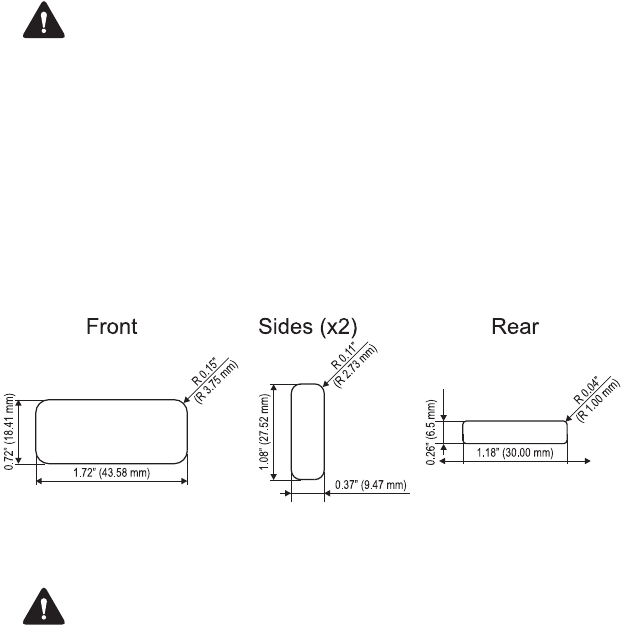
24 Before using your radio
For your safety
— battery
warning
Warning This radio uses a Lithium-ion battery. If the
battery is damaged or handled in an unsafe manner, it
can cause personal injury and/or damage to property.
Read the important safety information included with
your battery.
Attaching labels to the radio or
battery
The radio has recesses to attach labels to the front
(not for 16-key radio), both sides and the rear.
Please contact your Tait dealer for pre-printed,
customized labels.
Warning Do not cover the battery vent hole or the
vent hole on the radio chassis. If the vent on the
battery is obstructed, the battery may explode,
causing personal injury and/or damage to property.
If the vent on the radio is obstructed, audio quality
and/or key function may deteriorate and radio seals
may be damaged.
Notice Tait recommends that you do not affix
additional labels to the surfaces between the radio
chassis and the battery. The fit between these
surfaces is intentionally firm and any added thickness
will damage the points of attachment between radio
and battery.

Before using your radio 25
Charging the battery before first
use
Before using your battery for the first time, you must
charge it. Follow the instructions included with your
Tait charger. This information is repeated in the
section "Charging and caring for batteries" on
page 54.
For best charging performance, switch off the
radio before placing it in the charger.
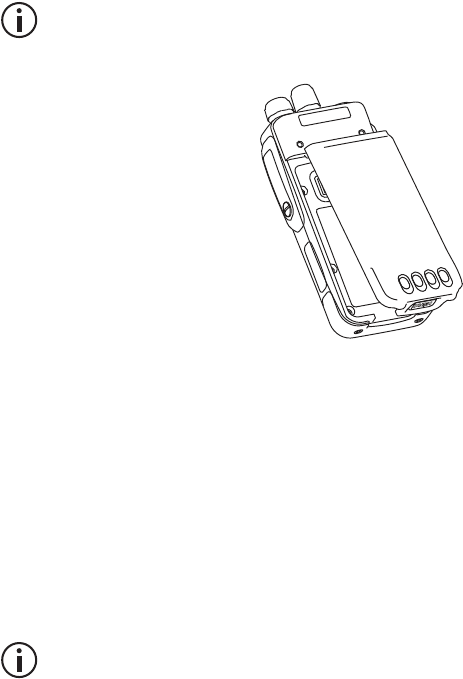
26 Before using your radio
Attaching the battery
1Rotate the power/volume control switch
counterclockwise to turn off the radio.
If the battery has been attached while the radio
is turned on, turn the radio off and then on again
before use.
2Insert the top of the
battery into the recess at
the back of the chassis.
3Lightly press the bottom
of the battery towards
the radio until the battery
catch clicks.
4Make sure that the
battery is firmly in
position.
Removing the battery
The battery is secured to the radio by a battery catch
in the radio’s rear panel.
To remove the battery from the radio, so that the
battery can be charged or replaced:
1Rotate the power/volume control switch
counterclockwise to turn off the radio.
If the battery has been removed while the radio
is turned on, turn the radio off and then on again
before use.
2Push the PRESS button at the bottom of the radio
to release the battery catch, and pull the battery
away from the radio.
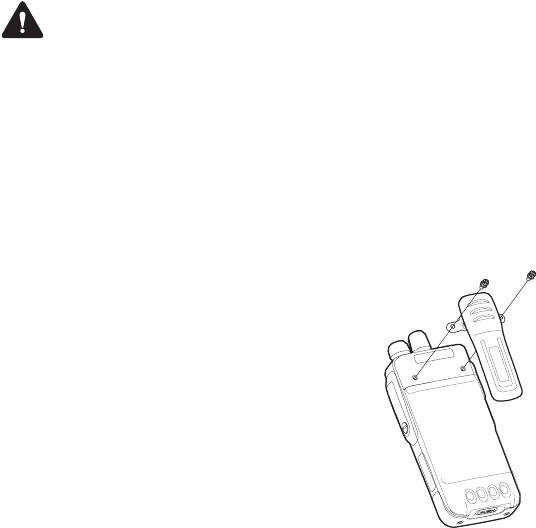
Before using your radio 27
Attaching the antenna
Before using the radio, screw the antenna clockwise
into the antenna connector. The antenna should be
screwed sufficiently tight so that it doesn’t unscrew
easily. This is important as it creates a seal.
Removing the antenna
Warning Do not change the antenna in a hazardous
location. An explosion could cause serious injury or
death.
Use a firm grip and turn the antenna counterclockwise
half a turn. Use a lighter grip to fully unscrew the
antenna, and carefully remove it.
Removing the belt clip
1To remove the belt clip, use a
Pozidrive screwdriver to undo
the two belt clip screws.
2To attach the belt clip, use a
Pozidrive screwdriver to fasten
the two belt clip screws.
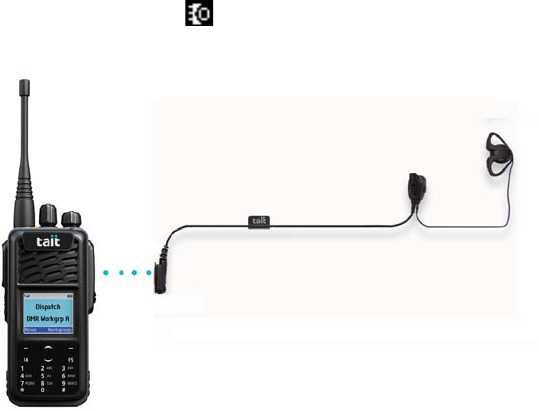
28 Before using your radio
Attaching an audio accessory
Audio accessories plug into the radio’s accessory
connector. The accessory connector is protected by a
cover, which needs to be removed before an
accessory can be installed.
Notice The accessory cover protects the accessory
connector from electrostatic discharge. Keep the
cover in place unless the connector is in use.
To remove the accessory cover and install an audio
accessory:
1Use a coin or other blunt object to loosen the screw
that secures the accessory cover to the radio.
2Remove the accessory cover and store it in a safe
place.
3Plug the accessory into the accessory connector.
4Tighten the screw.
5Once the radio has recognized the accessory, the
accessory icon will appear.
29 Getting started
3 Getting started
This section gives an overview of your DMR radio,
describes the radio’s controls and indicators, and
explains how the radio menus are organized.
This section covers:
■About your DMR digital radio
■About the radio controls
■Understanding the radio display
■Understanding the radio indicators
■Using function keys to access frequently used fea-
tures
■Navigating the radio’s menus
Getting started 30
About your DMR digital radio
Your DMR digital radio can be programmed for DMR
conventional. Analog conventional operation is also
available.
You may notice differences between digital and
analog calls in terms of:
■static noise in low signal areas, and
■radio coverage in marginal reception areas.
Lack of static noise
On digital networks there is no static noise, even in
low signal areas. This lack of static is because your
digital radio removes the ‘noise’ from the call, so that
you hear only clear voice.
Coverage
With digital networks, a call remains clear and then
drops off quickly at the border of a coverage area. The
reason for this is that a digital call is either received or
it isn't. With analog networks, the background noise in
a call gets progressively worse when you are in fringe
areas or even slightly outside normal coverage areas.
31 Getting started
What you hear on an analog channel
On analog channels, your radio may be programmed
so that you hear all conversations on a channel, or
your user group may be segregated from other user
groups by using special signaling. The special
signaling is used to control the muting and unmuting
of your radio, so that your radio is muted when other
user groups are talking and unmuted for members of
your user group.
There are two muting controls that operate in your
radio:
■signaling mute
■squelch
Signaling mute
The radio’s signaling mute only allows the radio to
unmute if the incoming call carries the tones specific
to your user group. Your user group may use tones
that are either audible, subaudible or both.
Squelch
The radio’s squelch allows the radio to unmute only
when the strength of the incoming signal is above a
predetermined threshold. This means that only
signals of reasonable intelligibility are made audible.
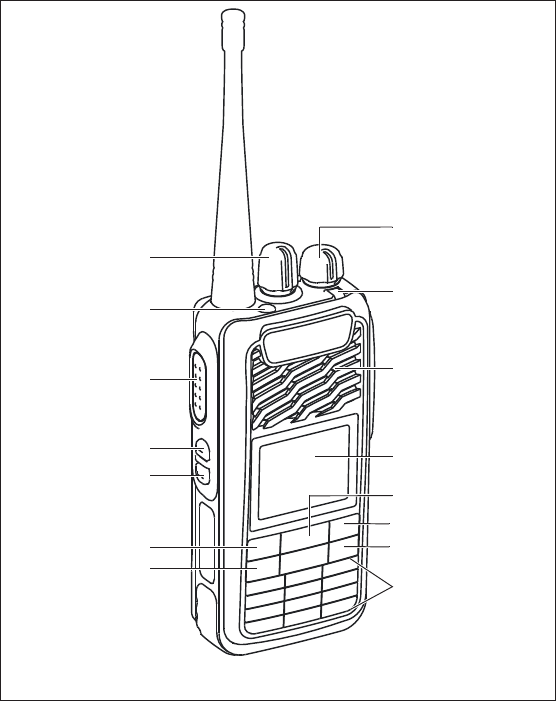
(press-to-talk)
Getting started 32
About the radio controls
The radio controls are the PTT key, power/volume
control, channel selector, scroll keys, selection keys,
and function keys. Some keys have functions
assigned to both short and long key presses:
■a short key press is less than one second, and
■a long key press is more than one second.
The radio controls and their functions are described in
the following sections.
display
PTT key
scroll keys
alphanumeric
keys
speaker /
microphone
channel selector
status LED
left selection key
function key 2
function key 3
right selection key
function key 1
(emergency key)
function key 4
function key 5
power / volume
control

33 Getting started
Name Function
PTT key Press and hold to transmit and release to
listen
Power/volume
control
Rotate to turn the radio on and change
the speaker volume
Channel
selector
Select and change channels
Left and right
selection keys
Action determined by the text above the
selection key
Scroll keys Scroll up and down through a list of menu
options, scroll left and right in messages,
or access a pre-programmed menu
Function keys Programmed for frequently used options
Alphanumeric
keys
Used to enter letters and numbers
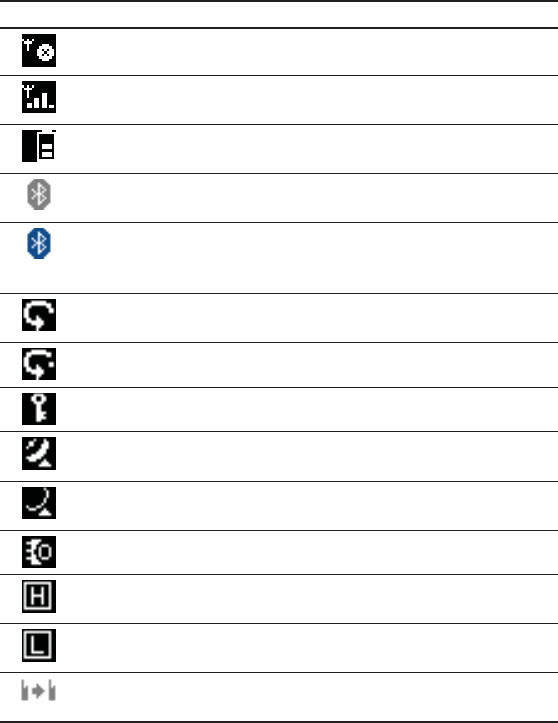
Getting started 34
Understanding the radio display
The messages and icons you see on your radio
display depend on the mode in which your radio is
operating and the way it is programmed.
Radio display icons
These are some of the icons you may see on your
radio display:
Icon Meaning
No signal.
Signal strength indicator: the more bars, the stronger the
signal being received by the radio
Battery indicator: shows how much charge is available in
the battery.
Bluetooth: The Bluetooth feature is enabled but there is no
remote Bluetooth device connected.
Bluetooth connected: The Bluetooth feature is enabled. The
icon stays lit when one or more remote Bluetooth devices
are connected.
Scanning: your radio is monitoring a group of channels or
workgroups for activity.
Scan land on: Scan feature is enabled.
Encryption: Encryption is turned on.
GPS available: GPS is turned on. The icon stays lit when a
position fix is available.
GPS not available/out of range: GPS is turned on. The icon
stays lit when a position fix is available.
Accessories connected.
High-power transmit: Your radio is set to transmit on high
power.
Low-power transmit: Your radio is set to transmit on low
power.
Direct mode (talkaround mode). In repeater mode no icon is
shown.
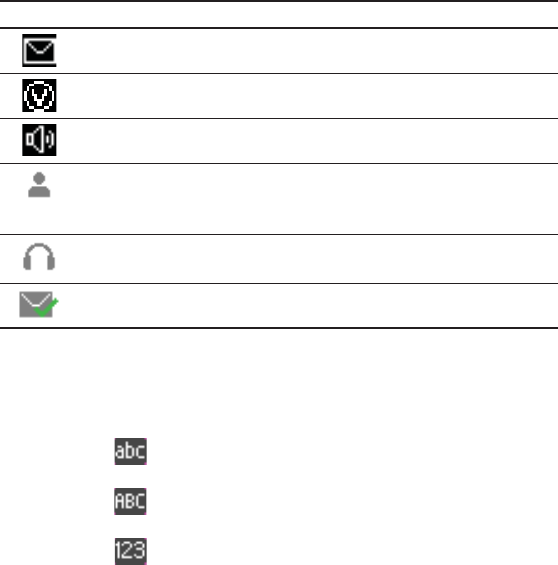
35 Getting started
Switch Input Method
Long-press the # key to switch input method between:
■ lowercase
■ uppercase
■ numeric
Unread message.
VOX enabled.
Speaker open.
Private Call
Indicates a Private Call in progress. In the Contacts list, it
indicates a subscriber alias (name) or ID (number).
Bluetooth Audio Device
Bluetooth-enabled audio device, such as a headset.
Item sent successfully.
Icon Meaning
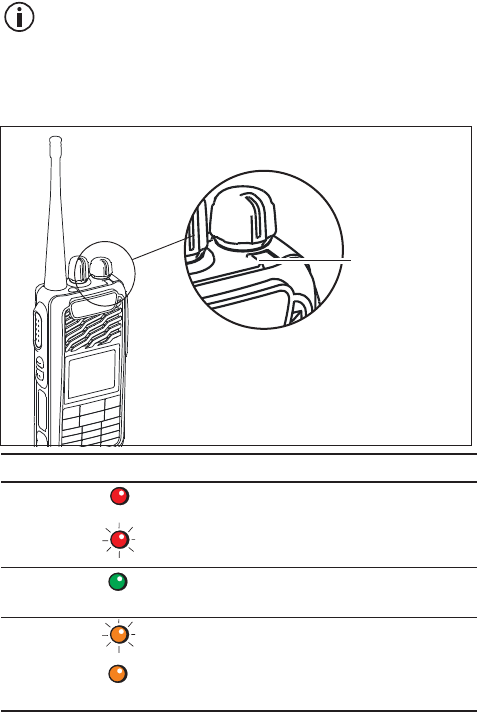
Getting started 37
Understanding the radio
indicators
The status LED indicator and the radio’s audible
tones—together with the radio display—all combine to
give you information about the state of your radio.
The most common way the indicators work is
described in the following sections.
The way these indicators behave may be
affected by the way your radio is programmed.
Status indicators
Color Meaning
Red On: The radio is transmitting.
Flashing: The battery is low.
Green On: The radio is receiving, or detecting
activity over the air.
Orange On: The radio is powering up.
Flashing: The Radio is scanning, or in
selective call, or emergency state.
status LED

38 Getting started
Audible tones
Warning Your radio may be programmed to be silent,
which means you may not hear any alerts.
The radio uses audible tones to alert you to its status:
■Radio controls and keypress tones—the tones
and beeps you hear when you press your radio’s
keys or use the controls.
■Incoming call tone—when the radio is receiving
a call.
■Warning tones—when there is an error, or the bat-
tery is low, for example.
Voice annunciation
Your radio may be programmed to play a pre-
recorded message
■for start-up channel
■when changing the channel
■for the battery condition
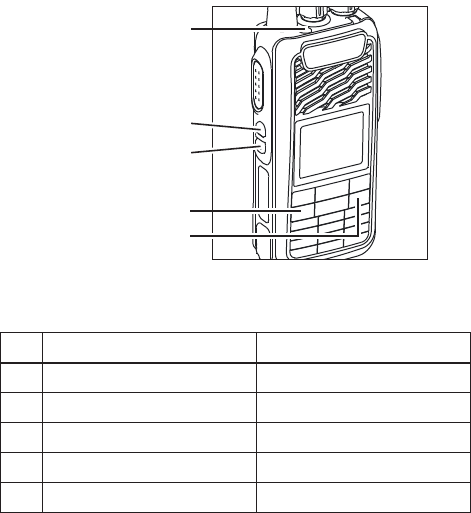
Getting started 38
Using function keys to access
frequently used features
The function keys provide access to some of the
features you will use most often. These features are
assigned to the function keys when the radio is
programmed. Some keys may have a feature
associated with both a short key press and a long key
press.
Use the following table to record the function keys
programmed for your radio:
For more information about the function keys that can
be programmed on your radio, contact your radio
provider.
Short key press Long key press
F1
F2
F3
F4
F5
function key 1
(emergency key)
function key 2
function key 4
function key 5
function key 3
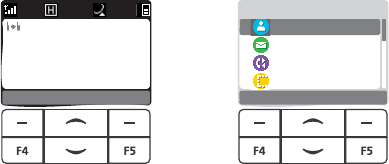
39 Getting started
Navigating the radio’s menus
Radios with display have a number of menus, each
containing lists or submenus. The menus available
depend on the way your radio is programmed.
See also "Menu map" on page 20.
To access the menu, press the left selection key
whenever Menu appears above it.
Use the scroll keys to move through the menu list.
When the menu you want is highlighted, press Select
(left selection key).
To go back one level, press Back (right selection key).
Menu
Channel 3
Zone 1
Select Back
Contacts
Message
Call Log
Zone
Main Menu
Operation 40
4 Operation
This section describes the basic operation of your
radio.
This section covers:
■Turning the radio on and off
■Adjusting the speaker volume
■Connecting to a Bluetooth® device (TP3350 only)
■Selecting a zone
■Selecting a channel
■Making a group call
■Making a private call
■Turning scanning on and off
■Making a call alert
■Sending a quick text message
■Sending an emergency alarm
■Turning location information on and off
(TP3350 only)

41 Operation
Turning the radio on and off
Rotate the On/Off/Volume control switch clockwise
until you hear a click. You see a welcome message or
welcome image.
The LED lights up solid orange and the Home screen
lights up if the backlight setting is set to turn on
automatically.
To turn off the radio, rotate the switch
counterclockwise until you hear a click. You see a
brief Powering Down on the radio’s display.
Your radio may not turn on if your battery is very
low. (See "Low battery warning" on page 57.)
Security lock on power-up feature
Your radio may be automatically locked each time it is
powered-up.
1Power up the radio.
2Enter your current six-digit password with the radio
keypad. The display shows ******.
You hear a positive indicator tone for every digit
pressed.
3Press the right selection key to remove the each *
on the display.
4Press the left selection key to proceed.
If the password is correct, your radio proceeds to
power up.
If the password is incorrect, the display shows
Password Input Error. Repeat step 2.

Operation 42
Adjusting the speaker volume
Rotate the power/volume control clockwise to
increase the speaker volume and counterclockwise to
decrease the volume.
The volume control also changes the volume
level of the radio’s audible indicators.
Connecting to a Bluetooth®
device (TP3350 only)
You may be able to connect a Bluetooth device to
your radio.
Compatibility with Tait radios
Bluetooth devices may operate with Tait radios,
provided they:
■are compatible with the Bluetooth Specification
Version 2.0 or higher. Tait recommends Bluetooth
Specification Version 2.1 or higher.
■include Bluetooth Headset Profile (HSP) adopted
version 1.1 or 1.2, or Bluetooth Handsfree Profile
(HFP) version 1.5 or 1.6.
Wearing a Bluetooth headset
Place the headset on your ear. Depending on which
ear you are going to wear the headset, simply adjust
the ear hook accordingly.
To get the best performance from your headset:
1Do not block the device’s internal antenna (see the
device’s user documentation). The human body
can interfere with a Bluetooth signal.
2If you usually use your radio with your right hand,
wear the headset on your right ear.

43 Operation
3Avoid coming in contact with the internal antenna
of a headset or radio.
Pairing a Bluetooth device with the radio
Before attempting to connect a device, Tait
recommends that the device is fully charged.
Refer to the documentation of your Bluetooth
device for charging instructions.
Pairing creates a unique and encrypted wireless link
between the radio, and the Bluetooth device. To use
a device with your radio, they must first be paired.
When you connect to a Bluetooth device for the first
time, you need to instruct the radio to search for
compatible devices using Bluetooth wireless
technology. The search should take less than one
minute.
Do not turn off your Bluetooth device or press
the right selection key during the finding and
connecting operation as this cancels the
operation.
A pin code may be required to be programmed in your
radio before it can pair with some devices. Contact
your dealer for more information.
16-key and 4-key radios
1Turn on your Bluetooth device and place it in
pairing mode. Refer to the documentation of your
Bluetooth device.
2On your radio, press Menu and
select Accessories.
3Select Bluetooth >
My Devices.
If you cannot see My Devices, turn on the
BT On/Off setting.
4Scroll to the required device and press Select.
You can also use Search Devices to locate
available devices.
Select Back
GPS
Bluetooth
Accessories
Operation 44
5Select Connect.
The display shows Connecting to <device>.
Your Bluetooth device may require additional steps to
complete the pairing. Refer to the documentation of
your Bluetooth-enabled device.
If successful, the radio display shows <Device>
Connected. A tone sounds and appears beside the
connected device. The Bluetooth Connected icon
appears on the status bar, or
if unsuccessful, the radio display shows Connected
Failed.
No-key no-display radio
1Turn on your Bluetooth device and place it in
pairing mode. Refer to the documentation of your
Bluetooth device.
2On your radio, press the function key programmed
for Bluetooth Connect.
A tone sounds and the LED blinks orange.
Your Bluetooth device may require additional steps to
complete the pairing. Refer to the documentation of
your Bluetooth device.
If successful, a positive tone sounds, or
if unsuccessful, a negative indicator tone sounds.

45 Operation
Selecting a zone
A zone is a group of channels.
The 16-key and 4-key radios support up to 2000
channels and 250 zones, with a maximum of 160
channels per zone.
The non-keypad radio supports up to 32 channels and
two zones, with a maximum of 16 channels per zone.
16-key and 4-key radios
■Press the function key programmed for Zone.
or
1Press Menu and select Zone.
The selected zone is indicated
by a .
2Scroll to the required zone and
press Select.
No-key no display radio
■Press the function key programmed for Zone.
You hear a positive indicator tone, indicating the radio
has switched from Zone 1 to Zone 2.
or
You hear a negative indicator tone, indicating the
radio has switched from Zone 2 to Zone 1.
Selecting a channel
Once the required zone is displayed (if you have
multiple zones in your radio), turn the channel selector
to select the channel.
Select Back
Zone 1
Zone 2
Zone 2/2

Operation 46
Making a group call
1Turn the channel selector to select the channel
with the active group alias or ID.
2Hold the radio vertically one to two inches (2.5 to
5 cm) from your mouth.
3Press the PTT key to make the call.
The LED lights up solid red and the Group Call icon
appears. The first text line shows the group call
alias.
4Wait for the Talk Permit tone to finish (if enabled)
and speak clearly into the microphone, or
wait for the PTT side tone to finish (if enabled) and
speak clearly into the microphone.
5Release the PTT key to listen.
When the called radio responds, the LED lights up
green. You see the Group Call icon , the group
alias or ID, and transmitting radio alias or ID on
your display.
6Your radio may be programmed to create a short
alert tone the moment the target radio releases the
PTT key, indicating the channel is free for you to
respond. Press the PTT key to respond.
or
If there is no voice activity for a predetermined
period of time, the call ends.
7The radio returns to the screen you were on prior
to initiating the call.

47 Operation
Making a private call
1Turn the channel selector to select the channel
with the active subscriber alias or ID.
2Hold the radio vertically one to two inches (2.5 to
5 cm) from your mouth.
3Press the PTT key to make the call.
The LED lights up red. The Private Call icon
appears. The first text line shows the subscriber
alias. The second text line displays the call status.
4Wait for the Talk Permit tone to finish (if enabled)
and speak clearly into the microphone.
5Release the PTT key to listen.
When the target radio responds, the LED lights up
green.
6Your radio may be programmed to create a short
alert tone the moment the target radio releases the
PTT key, indicating the channel is free for you to
respond. Press the PTT key to respond.
or
If there is no voice activity for a predetermined
period of time, the call ends.
7You hear a short tone. The display shows
Call Ended.
Turning scanning on and off
16-key and 4-key radios
■Press the function key programmed to turn scan
on and off.
or
1Press Menu and select Scan > Scan Switch.
2Select On or Off.
If you cannot turn on scanning, select a scan list
first (Scan > Scan List).

Operation 48
During scan, the LED flashes orange and the Scan
icon is displayed.
No-key no-display radio
■Press the function key programmed to turn scan
on or off.
During scan, the LED flashes orange.
Making a call alert
16-key and 4-key radios
■Press the function key programmed to make a call
alert to the predefined ID.
or
1Press Menu and select Contacts > Contact List.
2Scroll to required contact and press Select.
3Select Ctrl Services and Call Alert.
or (for 16-key radio only)
1Press Menu and select Contacts > Manual Dial.
2Enter the subscriber ID you want to page and
press Confirm.
3In the Ctrl Services menu
select Call Alert.
The display shows Call Alert and
the subscriber alias or ID, indicating
that the call alert has been sent.
The LED flashes red when your radio is sending the
call alert.
If the call alert acknowledgement is received, the
display briefly shows Success!
If the call alert acknowledgement is not received, the
display briefly shows Failed!
Select Back
Rad Check
Call Alert
R, Monitor
Rad Enable
Ctrl Services

49 Operation
No-key no-display radio
■Press the function key programmed to make a call
alert to the predefined contact.
The LED flashes when your radio is sending the call
alert.
If the Call Alert acknowledgement is received, two
chirps sound.
or
If the Call Alert acknowledgement is not received, a
low-pitched tone sounds.
Sending a quick text message
16-key radio
■Press the function key programmed to send a pre-
defined quick text message to a predefined con-
tact.
or
■Press the function key programmed to open the
Quick Text function. Go to step 2 below.
or
1Press Menu and select Message > Quick Text.
2Scroll to the required quick text and press Select.
3Use the keypad to edit the message, if required.
a. Press to move to the left.
b. Press to move to the right.
c. Press the * key to delete any unwanted
characters.
d. Press the # key to input one space to the right.
e. Long-press the # key to switch between
lowercase, upperacase and numeric input.
4Press Confirm.

Operation 50
You can also press the right selectyion key to
quit the operation.
5Press Send.
You can also press Save to save the message
in the drafts.
6Select Contact List, scroll to the required contact
and then press Select.
or
Select Manual Dial end enter the subscriber ID
and press Confirm.
The display shows Sending Msg... and the LED
flashes red.
If the message is sent, a tone sounds and the display
Send Success!
or
If the message is not sent, a low tone sounds and the
display shows Send Failed!
4-key radio
■Press the function key programmed to open the
Quick Text function. Go to step 2 below.
or
1Press Menu and select Message > Quick Text.
2Scroll to the required quick text and press Select.
3Scroll to the required contact and press Select.
The display shows Sending Msg... and the LED
flashes red.
If the message is sent, a tone sounds and the display
Send Success!
or
If the message is not sent, a low tone sounds and the
display shows Send Failed!

51 Operation
No-key no-display radio
■Press the function key programmed to send a pre-
defined quick text message to a predefined ID.
The LED flashes red.
Two chirps indicate that the message has been sent,
or
a low-pitched tone indicates that the message cannot
be sent.
Sending an emergency alarm
If your radio is set to silent, it will not display any
audio or visual indicators during Emergency
mode.
■Press the function key programmed for emer-
gency.
The display shows Tx Alarm and the destination
alias. The LED blinks red and the Emergency icon
appears.
or
The radio will send an emergency telegram. You can
now press PTT to make an emergency call, and
receive by releasing PTT. After a call hang time, the
radio return to its normal working state.
or
The radio will send an emergency telegram and then
transmit voice from the microphone for a preset time.
And then goes back to normal working state. Then the
radio return to its normal working state

Operation 52
Turning location information on
and off (TP3350 only)
Your radio may be enabled to send location
information.
16-key and 4-key radios
1Press Menu and select Accessories > GPS.
2Select GPS On/Off and select on or off.
When GPS is turned on, the GPS icon will
appear. Once a GPS signal is available, the GPS
icon will change to .
No-key no-display radio
■Press the function key programmed for GPS to
turn GPS on or off.
If turned on, a positive tone sounds. If turned off, a
negative tone sounds.
53 Charging and caring for batteries
5 Charging and caring for
batteries
This section describes how to charge your Tait radio
battery as well as care for it, to ensure safe operation,
maximum performance and prolonged battery life.
This section covers:
■About the chargers
■6-way charger safety information
■Before using the charger
■Charging temperatures
■Leaving the battery on charge
■Receiving calls while charging
■Low battery warning
■Charging a battery for the first time
■Charging a battery
■LED behavior
■Removing the battery from the charger
■Maintaining battery life and performance
■Storing batteries
■Disposing of batteries
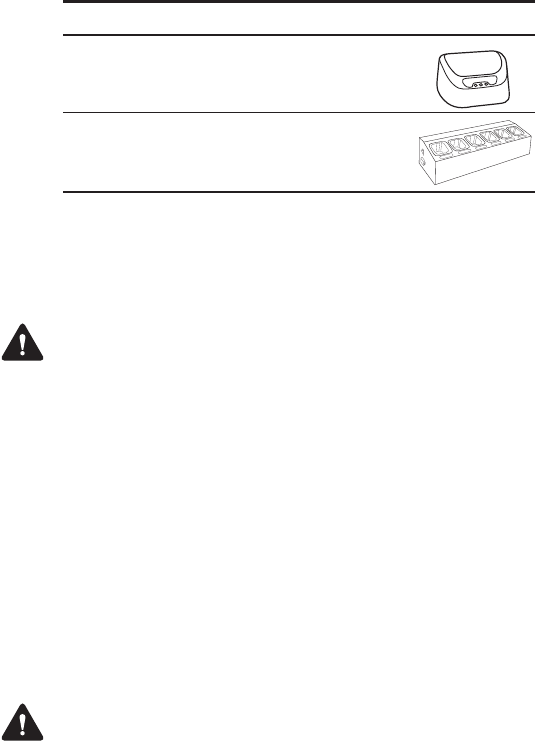
TP3300/TP3350 6-way charger
TP3300/TP3350 Desktop charger
Charging and caring for batteries 54
About the chargers
Unless otherwise indicated, the charging advice and
instructions in this document apply to all chargers.
The following chargers are available for your Tait
radios and batteries:
6-way charger safety
information
Warning This device must be connected to an
earthed mains socket-outlet.
Norsk (no): Apparatet må tilkoples jordet stikkontakt.
Suomi (fi): Laite on liitettävä suojamaadoitus-
koskettimilla varustettuun pistorasiaan.
Svenska (sv): Apparaten skall anslutas till jordat
uttag.
Before using the charger
Check the battery label and charger label to see if the
charger is compatible with the battery. See also
"About the chargers" on page 55.
Warning Handle the battery safely. Failure to
observe the following handling recommendations
could result in personal injury and/or equipment
damage.
Part number range Designation
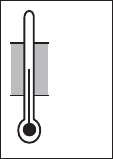
55 Charging and caring for batteries
■Before using a Li-ion battery, read the Li-ion Bat-
tery Safety Information (MPC-00006-xx) included
with your battery, and follow the instructions it pro-
vides. Incorrect use of a Li-ion battery can cause
explosion or fire.
■Do not short-circuit the battery contacts, neither
intentionally nor accidentally, e.g. by placing the
battery with conductive materials such as keys or
jewelry inside a pocket or container. Short-circuit-
ing the battery contacts can heat up the conduc-
tive material.
■Do not obstruct the vent hole(s) on the battery.
If the vent on the battery is obstructed the battery
may explode, causing personal injury and/or
equipment damage. If the vent on the radio is
obstructed, audio quality and/or key function may
deteriorate and radio seals may be damaged.
Notice Turn the radio off before removing the battery,
and turn it on again after attaching the battery. This
ensures that the radio powers down and up correctly.
Failing to follow this procedure may require the radio
to be turned off then on again to operate correctly.
Charging temperatures
Notice Do not expose a battery to very high or very
low temperatures for extended periods of time. Doing
so will shorten the usable life (‘service life’) of the
battery.
To achieve the best results when charging your
battery:
■Before you begin to charge your
battery, make sure that the battery
temperature is close to the room
temperature in which the battery is
to be charged.
■If possible, charge the battery in
temperatures between 50 °F
and 77 °F (between 10 °C and 25 °C).
77 °F
25 °C
50 °F
10 °C

Charging and caring for batteries 56
This temperature range is the optimal charging
range.
Charging only starts when the battery is between
32 °F to 104 °F (0 °C to 40 °C).
When the battery temperature is outside the normal
charging range, the orange LED on the charger is lit.
Charging will start or resume once the temperature is
within normal limits, and no action is required by you.
Leaving the battery on charge
You can leave a battery/radio in the charger once
charging is complete. Leaving a battery in the charger
will not overcharge or damage it.
You can remove a battery/radio from the charger at
any time without harming the battery, the radio, or the
charger. When you return the battery/radio to the
charger, charging is automatically resumed.
Receiving calls while charging
Notice For best charging performance, switch off the
radio before placing it in the charger.
You can receive a call while the radio is in the charger,
but your radio performance may be degraded. If you
do remove the radio from the charger to answer a call,
the call will not be disrupted.
Removing the radio from the charger to make or
receive a call ends the charging process. Charging
safely recommences when the radio is reinserted into
the charger.
Low battery warning
Notice Do not allow a radio battery to fully discharge
every time you use it, or you will shorten the service
life of the battery.

57 Charging and caring for batteries
When the battery is low, your radio warns you in the
following ways:
■The battery symbol on the radio display looks
empty.
■The status LED on the radio slowly flashes red.
■A high-pitched beep sounds.
You should recharge or replace the battery as soon
as possible.
Charging a battery for the first
time
Fully charge a battery before using it for the first time.
The red LED stays lit while the battery charges.
Charging a battery
Notice For best charging performance, switch off the
radio before placing it in the charger.
1Desktop charger: Connect the charger to the
correct Tait power adaptor.
6-way charger: Power on the charger.
Initially, all three LEDs are lit for 2 seconds.
2Place just a battery in the charger, or a radio with
a battery attached (desktop charger or 6-way
charger only). There is no need to remove a belt
clip, antenna, or any accessory that is attached to
the accessory connector.
The red LED lights up, and stays lit while the
battery charges.
When charging is complete, the green LED stays
lit.
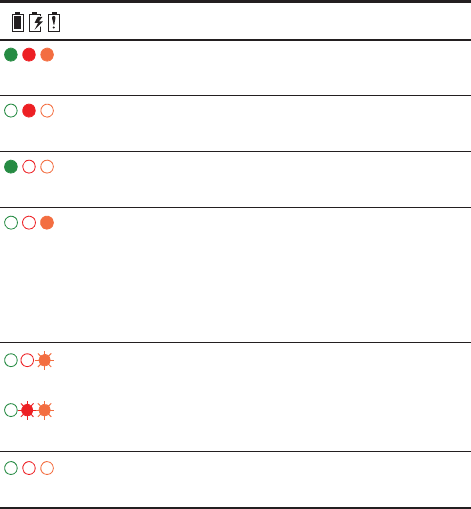
Charging and caring for batteries 58
LED behavior
If there is a battery in the charger when power is
supplied to the charger, the LEDs behave as follows:
If the charger does not behave as expected:
■Make sure the radio or battery is seated properly
in the charger.
■Check that the charger is properly plugged into
the originally supplied power supply.
■Check that the battery and charger contacts are
clean. To clean, wipe the contacts with a dry lint-
free cloth to remove any dirt, oil or grease.
Meaning
briefly
The charger has been connected to a power
supply.
steady
The battery is charging.
steady
Charging complete. Remove the battery, or
leave it in the charger.
steady
■The battery temperature is outside the nor-
mal charging range. Charging will start or
resume once the temperature is within nor-
mal limits. No action is required by you.
■There is a fault. Contact your dealer.
or
flashing
If the LEDs for all charger slots continuously
flash orange, or red then orange, the charger
itself may be faulty (e.g. the 6-way charger fan
may be jammed). Contact your dealer.
all off
There is a fault. Contact your dealer.
59 Charging and caring for batteries
Removing the battery from the
charger
■Lift the battery/radio out of the charger.
You can remove a battery/radio from the charger at
any time without harming the battery, the radio, or the
charger. When you return the battery/radio to the
charger, charging is automatically resumed. You can
also leave a battery/radio in the charger once
charging is complete.
Maintaining battery life and
performance
With proper care and maintenance you will maintain
the performance and life of the battery. It is
recommended that you:
■Use only Tait chargers and batteries.
■Do not expose a battery to very high or very low
temperatures for extended periods of time. Doing
so will shorten the service life of the battery.
Very high: above 140 °F (60 °C)
Very low: less than –4 °F (–20 °C)
■Charge the battery at a room temperature of
between 50 °F and 77 °F (between 10 °C and
25 °C). This temperature range is the optimal
charging range.
■Wipe excess moisture and dirt from the radio,
radio contacts and battery contacts before charg-
ing the battery.
■Store batteries properly when not in use.
See "Storing batteries".
Storing batteries
When not in use for a month or more, batteries should
be stored correctly to prolong their life.

Charging and caring for batteries 60
■Remove the battery from the radio before storage.
■Fully charge the battery if storing for less than one
month.
■Charge batteries to about 30% if storing for longer
than one month.
■Store in a cool dry place.
Batteries that have been stored for any length of time
must be charged before being used. See "Charging a
battery for the first time" on page 58.
Disposing of batteries
Run the battery flat before disposing of it. When
disposing of the battery, be sure to do so in an
environmentally sensitive manner. Please contact
your radio provider for information on recycling
programs in your area. See "Environmental
responsibilities" on page 6 for more information.
61 Troubleshooting
6 Troubleshooting
This section describes troubleshooting procedures,
and basic maintenance.
This section covers:
■About troubleshooting
■When your radio won’t turn on
■Identifying the radio’s audible tones
■Viewing radio information
■General care
Troubleshooting 62
About troubleshooting
If you are experiencing difficulty operating your radio,
you may find the following sections helpful. Consult
your radio provider for assistance, if necessary.
When your radio won’t turn on
If the LED on your radio does not glow red when the
radio is turned on, it is probable that power is not
reaching the radio. Check the following:
■Is the battery firmly attached to the radio?
■Is the battery sufficiently charged?
■Is the battery charger working properly?
If all appears to be in order, but your radio still fails to
operate properly, contact your radio provider for
further assistance.
Identifying the radio’s audible
tones
The radio’s audible tones can help you identify a
potential problem. See "Audible tones" on page 38.
Viewing radio information
Your radio provider may ask you for the hardware
and firmware version of your radio, for
troubleshooting purposes.
Use the Radio Info menu to view information such as
the hardware and firmware version of your radio, the
radio serial number, and various radio identities.
1Press Menu and select Settings > Radio Info.
2Scroll to the radio information you want to view.
63 Troubleshooting
General care
Your radio requires no regular maintenance other
than ensuring that the battery has sufficient charge
and that no damage has occurred to the antenna or
the battery.
Notice To prevent permanent damage to the radio
case, do not allow the radio to come into contact with
detergents, alcohol, aerosol sprays, or petroleum-
based products.
For general battery care, see "Maintaining battery life
and performance" on page 60.
Cleaning the contacts of the battery
Notice Do not scratch or scrape the contacts of the
battery. If necessary, wipe the contacts of the battery
with a dry, lint-free cloth to remove any dirt, oil or
grease.
Cleaning the radio
If you need to clean the radio case, use a cloth
dampened with clean water. Do not immerse the radio
in fluids.
Tait Software Licence Agreement 64
Tait Software Licence Agreement
This Software License Agreement
("Agreement") is between you
(“Licensee”) and Tait Limited (“Tait").
By using any of the Software items
embedded and pre-loaded in the
related Tait Designated Product,
included on CD, downloaded from the
Tait website, or provided in any other
form, you agree to be bound by the
terms of this Agreement. If you do not
agree to the terms of this Agreement,
do not install or use any of the
Software. If you install or use any of
the Software, that will be deemed to be
acceptance of the terms of this
Agreement.
For good and valuable consideration,
the parties agree as follows:
SECTION 1 DEFINITIONS
“Confidential Information” means all
or any information supplied to or
received by Licensee from Tait,
whether before or after installation or
use and whether directly or indirectly
pertaining to the Software and
Documentation supplied by Tait,
including without limitation all
information relating to the Designated
Products, hardware, software;
copyright, design registrations,
trademarks; operations, processes,
and related business affairs of Tait;
and including any other goods or
property supplied by Tait to Licensee
pursuant to the terms of this
Agreement.
“Designated Products” means
products provided by Tait to Licensee
with which or for which the Software
and Documentation is licensed for
use.
“Documentation” means product and
software documentation that specifies
technical and performance features
and capabilities; user, operation, and
training manuals for the Software; and
all physical or electronic media upon
which such information is provided.
“Executable Code” means Software
in a form that can be run in a computer
and typically refers to machine
language, which is comprised of native
instructions the computer carries out in
hardware. Executable code may also
refer to programs written in interpreted
languages that require additional
software to actually execute.
“Intellectual Property Rights” and
“Intellectual Property” mean the
following or their substantial
equivalents or counterparts,
recognized by or through action before
any governmental authority in any
jurisdiction throughout the world and
including, but not limited to all rights in
patents, patent applications,
inventions, copyrights, trademarks,
trade secrets, trade names, and other
proprietary rights in or relating to the
Software and Documentation;
including any adaptations, corrections,
de-compilations, disassemblies,
emulations, enhancements fixes,
modifications, translations and
updates to or derivative works from,
the Software or Documentation,
whether made by Tait or another party,
or any improvements that result from
Tait processes or, provision of
information services.
“Licensee” means any individual or
entity that has accepted the terms of
this License.
“Open Source Software” means
software with freely obtainable source
code and license for modification, or
permission for free distribution.
“Open Source Software License”
means the terms or conditions under
which the Open Source Software is
licensed.
65 Tait Software Licence Agreement
“Person” means any individual,
partnership, corporation, association,
joint stock company, trust, joint
venture, limited liability company,
governmental authority, sole
proprietorship, or other form of legal
entity recognized by a governmental
authority.
“Security Vulnerability” means any
flaw or weakness in system security
procedures, design, implementation,
or internal controls that if exercised
(accidentally triggered or intentionally
exploited) could result in a security
breach such that data is compromised,
manipulated, or stolen, or a system is
damaged.
“Software” (i) means proprietary
software in executable code format,
and adaptations, translations, de-
compilations, disassemblies,
emulations, or derivative works of
such software; (ii) means any
modifications, enhancements, new
versions and new releases of the
software provided by Tait; and (iii) may
contain one or more items of software
owned by a third-party supplier. The
term "Software" does not include any
third-party software provided under
separate license or not licensable
under the terms of this Agreement.
“Source Code” means software
expressed in human readable
language necessary for
understanding, maintaining,
modifying, correcting, and enhancing
any software referred to in this
Agreement and includes all states of
that software prior to its compilation
into an executable programme.
“Tait” means Tait Limited and
includes its Affiliates.
SECTION 2 SCOPE
This Agreement contains the terms
and conditions of the license Tait is
providing to Licensee, and of
Licensee’s use of the Software and
Documentation. Tait and Licensee
enter into this Agreement in
connection with Tait delivery of certain
proprietary Software and/or products
containing embedded or pre-loaded
proprietary Software.
SECTION 3 GRANT OF
LICENSE
3.1. Subject to the provisions of this
Agreement and the payment of
applicable license fees, Tait grants to
Licensee a personal, limited, non-
transferable (except as permitted in
Section 7), and non-exclusive license
to use the Software in executable code
form, and the Documentation, solely in
connection with Licensee's use of the
Designated Products for the useful life
of the Designated Products. This
Agreement does not grant any rights to
source code.
3.2. If the Software licensed under this
Agreement contains or is derived from
Open Source Software, the terms and
conditions governing the use of such
Open Source Software are in the Open
Source Software Licenses of the
copyright owner and not in this
Agreement. If there is a conflict
between the terms and conditions of
this Agreement and the terms and
conditions of the any applicable Open
Source Software Licenses, the terms
and conditions of the Open Source
Software Licenses will take
precedence. For information about
Open Source Components contained
in Tait products and the related Open
Source licenses, see:
http://support.taitradio.com/go/
opensource
SECTION 4 LIMITATIONS ON
USE
4.1. Licensee may use the Software
only for Licensee's internal business
purposes and only in accordance with
the Documentation. Any other use of
the Software is strictly prohibited.
Without limiting the general nature of
these restrictions, Licensee will not
make the Software available for use by
Tait Software Licence Agreement 66
third parties on a "time sharing,"
"application service provider," "service
bureau" basis, or for any other similar
commercial rental or sharing
arrangement.
4.2. Licensee will not, and will not
directly or indirectly allow or enable
any third party to: (i) reverse engineer,
disassemble, extract components,
decompile, reprogram, or otherwise
reduce the Software or any portion
thereof to a human perceptible form or
otherwise attempt to recreate the
source code; (ii) modify, adapt, create
derivative works of, or merge the
Software; (iii) copy, reproduce,
distribute, lend, or lease the Software
or Documentation to any third party;
(iv) grant any sublicense or other rights
in the Software or Documentation to
any third party; (v) take any action that
would cause the Software or
Documentation to be placed in the
public domain; (vi) remove, or in any
way alter or obscure any copyright
notice or other notice of Tait or third-
party licensor’s proprietary rights; (vii)
provide, copy, transmit, disclose,
divulge or make the Software or
Documentation available to, or permit
the use of the Software by, any third
party or on any machine except as
expressly authorized by this
Agreement; or (viii) use, or permit the
use of, the Software in a manner that
would result in the production of a copy
of the Software by any means
whatsoever other than what is
permitted in this Agreement. Licensee
may make one copy of the Software to
be used solely for archival, back-up, or
disaster recovery purposes; provided
that Licensee may not operate that
copy of the Software at the same time
as the original Software is being
operated. Licensee may make as
many copies of the Documentation as
it may reasonably require for the
internal use of the Software.
4.3. Unless otherwise authorized by
Tait in writing, Licensee will not, and
will not enable or allow any third party
to: (i) install a copy of the Software on
more than one unit of a Designated
Product; or (ii) copy or transfer
Software installed on one unit of a
Designated Product to any other
device. Licensee may temporarily
transfer Software installed on a
Designated Product to another device
if the Designated Product is inoperable
or malfunctioning. Temporary transfer
of the Software to another device must
be discontinued when the original
Designated Product is returned to
operation and the Software must be
removed from the other device.
4.4. Licensee will maintain, during the
term of this Agreement and for a
period of two years thereafter,
accurate records relating to this
license grant to verify compliance with
this Agreement. Tait, or a third party
nominated by Tait, may inspect
Licensee’s premises, books and
records, upon reasonable prior notice
to Licensee, during Licensee’s normal
business hours and subject to
Licensee's facility and security
regulations. Tait is responsible for the
payment of all expenses and costs of
the inspection, provided that Licensee
shall indemnify Tait for all costs
(including audit costs and legal costs
on a solicitor client basis) if Licensee
has breached the terms of this
Agreement. Any information obtained
by Tait during the course of the
inspection will be kept in strict
confidence by Tait and used solely for
the purpose of verifying Licensee's
compliance with the terms of this
Agreement.
SECTION 5 OWNERSHIP AND
TITLE
Tait, its licensors, and its suppliers
retain all of their Intellectual Property
Rights in and to the Software and
Documentation, in any form. No rights
are granted to Licensee under this
Agreement by implication, estoppel or
67 Tait Software Licence Agreement
otherwise, except for those rights
which are expressly granted to
Licensee in this Agreement. All
Intellectual Property developed,
originated, or prepared by Tait in
connection with providing the
Software, Designated Products,
Documentation, or related services,
remains vested exclusively in Tait, and
Licensee will not have any shared
development or other Intellectual
Property Rights.
SECTION 6 LIMITED
WARRANTY; DISCLAIMER
OF WARRANTY
6.1. The commencement date and the
term of the Software warranty will be a
period of one (1) year from Tait
shipment of the Software. If Licensee
is not in breach of any obligations
under this Agreement, Tait warrants
that the unmodified Software, when
used properly and in accordance with
the Documentation and this
Agreement, will be free from a
reproducible defect that eliminates the
functionality or successful operation of
a feature critical to the primary
functionality or successful operation of
the Software. Whether a defect has
occurred will be determined solely by
Tait. Tait does not warrant that
Licensee’s use of the Software or the
Designated Products will be
uninterrupted, error-free, completely
free of Security Vulnerabilities, or that
the Software or the Designated
Products will meet Licensee’s
particular requirements. Tait makes no
representations or warranties with
respect to any third-party software
included in the Software.
6.2 Tait sole obligation to Licensee,
and Licensee’s exclusive remedy
under this warranty, is to use
reasonable efforts to remedy any
material Software defect covered by
this warranty. These efforts will involve
either replacing the media or
attempting to correct significant,
demonstrable program or
documentation errors or Security
Vulnerabilities. If Tait cannot correct
the defect within a reasonable time,
then at Tait option, Tait will replace the
defective Software with functionally
equivalent Software, license to
Licensee substitute Software which
will accomplish the same objective, or
terminate the license and refund
Licensee’s paid license fee. If Tait
investigation of the perceived defect
reveals that no such defect in fact
exists, Tait may recover its costs in
respect of such investigation from
Licensee.
6.3. Tait disclaims any and all other
warranties relating to the Software or
Documentation other than the express
warranties set forth in this Section 6.
Warranties in Section 6 are in lieu of all
other warranties whether express or
implied, oral or written, and including
without limitation any and all implied
warranties of condition, title, non-
infringement, merchantability, or
fitness for a particular purpose or use
by Licensee (whether Tait knows, has
reason to know, has been advised of,
or is otherwise aware of any such
purpose or use), whether arising by
law, by reason of custom or usage of
trade, or by course of dealing. In
addition, Tait disclaims any warranty
to any person other than Licensee with
respect to the Software or
Documentation.
SECTION 7 TRANSFERS
7.1. Licensee will not transfer the
Software or Documentation to any
third party without specific prior written
consent from Tait. Tait may withhold
such consent or at its own discretion
make the consent conditional upon the
transferee paying applicable license
fees and agreeing to be bound by this
Agreement.
7.2. In the case of a value-added
reseller or distributor of Tait
Designated Products, the consent
Tait Software Licence Agreement 68
referred to in Section 7.1 may be
contained in a Tait Reseller or Tait
Distributor Agreement.
7.3. If the Designated Products are
Tait vehicle-mounted mobile products
or hand-carried portable radio
products and Licensee transfers
ownership of the Tait mobile or
portable radio products to a third party,
Licensee may assign its right to use
the Software which is embedded in or
furnished for use with the radio
products and the related
Documentation; provided that
Licensee transfers all copies of the
Software and Documentation to the
transferee.
7.4. For the avoidance of any doubt,
Section 7.3 excludes TaitNet
Infrastructure, or the products listed at
any time under network products at:
http://www.taitradio.com.
7.5. If Licensee, as a contractor or
subcontractor (integrator), is
purchasing Tait Designated Products
and licensing Software not for its own
internal use but for end use only by a
Customer, the Licensee may transfer
such Software, but only if a) Licensee
transfers all copies of such Software
and the related Documentation to the
transferee and b) Licensee has first
obtained from its Customer (and, if
Licensee is acting as a subcontractor,
from the interim transferee(s) and from
the ultimate end user sub license) an
enforceable sublicense agreement
that prohibits any other transfer and
that contains restrictions substantially
identical to the terms set forth in this
Software License Agreement. Except
as stated in the foregoing, Licensee
and any transferee(s) authorised by
this Section may not otherwise
transfer or make available any Tait
Software to any third party nor permit
any party to do so. Licensee will, on
request, make available evidence
reasonably satisfactory to Tait
demonstrating compliance with all the
foregoing.
SECTION 8 TERM AND
TERMINATION
8.1. Licensee’s right to use the
Software and Documentation will
commence when the Designated
Products are supplied by Tait to
Licensee and will continue for the life
of the Designated Products with which
or for which the Software and
Documentation are supplied, unless
Licensee breaches this Agreement, in
which case this Agreement and
Licensee's right to use the Software
and Documentation may be
terminated immediately upon notice by
Tait.
8.2. Within thirty (30) days after
termination of this Agreement,
Licensee must certify in writing to Tait
that all copies of the Software have
been removed or deleted from the
Designated Products and that all
copies of the Software and
Documentation have been returned to
Tait or destroyed by Licensee and are
no longer in use by Licensee.
8.3. Licensee acknowledges that Tait
made a considerable investment of
resources in the development,
marketing, and distribution of the
Software and Documentation and that
Licensee's breach of this Agreement
will result in irreparable harm to Tait for
which monetary damages would be
inadequate. If Licensee breaches this
Agreement, Tait may terminate this
Agreement and be entitled to all
available remedies at law or in equity
including immediate injunctive relief
and repossession of all non-
embedded Software and associated
Documentation. Licensee shall pay all
Tait costs (on an indemnity basis) for
the enforcement of the terms of this
Agreement.
SECTION 9 CONFIDENTIALITY
Licensee acknowledges that the
Software and Documentation contain
proprietary and Confidential
Information valuable to Tait and are
69 Tait Software Licence Agreement
Tait trade secrets, and Licensee
agrees to respect the confidentiality of
the information contained in the
Software and Documentation.
SECTION 10 LIMITATION OF
LIABILITY
10.1. In no circumstances shall Tait be
under any liability to Licensee, or any
other person whatsoever, whether in
Tort (including negligence), Contract
(except as expressly provided in this
Agreement), Equity, under any
Statute, or otherwise at law for any
losses or damages whether general,
special, exemplary, punitive, direct,
indirect, or consequential arising out of
or in connection with any use or
inability of using the Software.
10.2. Licensee’s sole remedy against
Tait will be limited to breach of contract
and Tait sole and total liability for any
such claim shall be limited at the
option of Tait to the repair or
replacement of the Software or the
refund of the purchase price of the
Software.
SECTION 11 GENERAL
11.1. COPYRIGHT NOTICES. The
existence of a copyright notice on the
Software will not be construed as an
admission or presumption of
publication of the Software or public
disclosure of any trade secrets
associated with the Software.
11.2. COMPLIANCE WITH LAWS.
Licensee acknowledges that the
Software may be subject to the laws
and regulations of the jurisdiction
covering the supply of the Designated
Products and will comply with all
applicable laws and regulations,
including export laws and regulations,
of that country.
11.3. ASSIGNMENTS AND
SUBCONTRACTING. Tait may assign
its rights or subcontract its obligations
under this Agreement, or encumber or
sell its rights in any Software, without
prior notice to, or consent of, Licensee.
11.4. GOVERNING LAW. This
Agreement shall be subject to and
construed in accordance with New
Zealand law and disputes between the
parties concerning the provisions
hereof shall be determined by the New
Zealand Courts of Law. Provided
however Tait may at its election bring
proceedings for breach of the terms
hereof or for the enforcement of any
judgment in relation to a breach of the
terms hereof in any jurisdiction Tait
considers fit for the purpose of
ensuring compliance with the terms
hereof or obtaining relief for breach of
the terms hereof.
11.5. THIRD-PARTY
BENEFICIARIES. This Agreement is
entered into solely for the benefit of
Tait and Licensee. No third party has
the right to make any claim or assert
any right under this Agreement, and no
third party is deemed a beneficiary of
this Agreement. Notwithstanding the
foregoing, any licensor or supplier of
third-party software included in the
Software will be a direct and intended
third-party beneficiary of this
Agreement.
11.6. SURVIVAL. Sections 4, 5, 6.3, 7,
8, 9, 10, and 11 survive the termination
of this Agreement.
11.7. ORDER OF PRECEDENCE. In
the event of inconsistencies between
this Agreement and any other
Agreement between the parties, the
parties agree that, with respect to the
specific subject matter of this
Agreement, this Agreement prevails.
11.8. SECURITY. Tait uses
reasonable means in the design and
writing of its own Software and the
acquisition of third-party Software in
order to limit Security Vulnerabilities.
While no software can be guaranteed
to be free from Security Vulnerabilities,
if a Security Vulnerability is
discovered, Tait will take the steps
specified in Section 6 of this
Agreement.
Tait Software Licence Agreement 70
11.9. EXPORT. Licensee will not
transfer, directly or indirectly, any
Designated Product, Documentation
or Software furnished hereunder or the
direct product of such Documentation
or Software to any country for which
New Zealand or any other applicable
country requires an export license or
other governmental approval without
first obtaining such license or
approval.
11.10. SEVERABILITY. In the event
that any part or parts of this Agreement
shall be held illegal or null and void by
any court or administrative body of
competent jurisdiction, such
determination shall not affect the
remaining terms which shall remain in
full force and effect as if such part or
parts held to be illegal or void had not
been included in this Agreement. Tait
may replace the invalid or
unenforceable provision with a valid
and enforceable provision that
achieves the original intent and
economic effect of this Agreement.
11.11. CONSUMER GUARANTEES.
Licensee acknowledges that the
licenses supplied in terms of this
agreement are supplied to Licensee in
business, and that the guarantees and
other provisions of prevailing
consumer protection legislation shall
not apply.
11.12. WHOLE AGREEMENT.
Licensee acknowledges that it has
read this Agreement, understands it
and agrees to be bound by its terms
and conditions. Licensee also agrees
that, subject only to the express terms
of any other agreement between Tait
and Licensee to the contrary, this is
the complete and exclusive statement
of the Agreement between it and Tait
in relation to the Software. This
Agreement supersedes any proposal
or prior agreement, oral or written, and
any other communications between
Licensee and Tait relating to the
Software and the Designated
Products.
71 Simplified Declaration of Conformity
Simplified Declaration of Conformity
EN
Hereby, Tait Limited declares that the radio equipment
type TPEHGC, TPEHGD & TPEHGE is in compliance with
Directive 2014/53/EU.
The full text of the EU declaration of conformity is available at
the following internet address: www.taitradio.com/eudoc
BG
Tait Limited ,
TPEHGC, TPEHGD & TPEHGE
2014/53/.
:
www.taitradio.com/eudoc
ES
Por la presente, Tait Limited declara que el tipo de
equipo radioeléctrico TPEHGC, TPEHGD & TPEHGE es
conforme con la Directiva 2014/53/UE.
El texto completo de la declaración UE de conformidad está
disponible en la dirección Internet siguiente:
www.taitradio.com/eudoc
CS
Tímto Tait Limited prohlašuje, že typ rádiového
zaízení TPEHGC, TPEHGD & TPEHGE je v souladu se
smrnicí 2014/53/EU.
Úplné znní EU prohlášení o shod je k dispozici na této
internetové adrese: www.taitradio.com/eudoc
DA
Hermed erklærer Tait Limited, at radioudstyrstypen
TPEHGC, TPEHGD & TPEHGE er i overensstemmelse med
direktiv 2014/53/EU.
EU-overensstemmelseserklæringens fulde tekst kan findes
på følgende internetadresse: www.taitradio.com/eudoc
DE
Hiermit erklärt Tait Limited, dass der Funkanlagentyp
TPEHGC, TPEHGD & TPEHGE der Richtlinie 2014/53/EU
entspricht.
Der vollständige Text der EU-Konformitätserklärung ist unter
der folgenden Internetadresse verfügbar: www.taitradio.com/
eudoc
ET
Käesolevaga deklareerib Tait TPEHGC, TPEHGD &
TPEHGE vastab direktiivi 2014/53/EL nõuetele.
ELi vastavusdeklaratsiooni täielik tekst on kättesaadav
järgmisel internetiaadressil: www.taitradio.com/eudoc
EL
/ Tait Limited,
TPEHGC, TPEHGD & TPEHGE
2014/53/.
:
www.taitradio.com/eudoc
FR
Le soussigné Tait Limited, déclare que l'équipement
radioélectrique du type TPEHGC, TPEHGD & TPEHGE est
conforme à la directive 2014/53/UE.
Le texte complet de la déclaration UE de conformité est
disponible à l'adresse internet suivante: www.taitradio.com/
eudoc
HR
Tait Limited ovime izjavljuje da je radijska oprema tipa
TPEHGC, TPEHGD & TPEHGE u skladu s Direktivom 2014/
53/EU.
Cjeloviti tekst EU izjave o sukladnosti dostupan je na
sljedeoj internetskoj adresi: www.taitradio.com/eudoc
IT
Il fabbricante, Tait Limited, dichiara che il tipo di
apparecchiatura radio TPEHGC, TPEHGD & TPEHGE è
conforme alla direttiva 2014/53/UE.
Il testo completo della dichiarazione di conformità UE è
disponibile al seguente indirizzo Internet: www.taitradio.com/
eudoc
LV
Ar šo Tait Limited deklar, ka radioiekrta TPEHGC,
TPEHGD & TPEHGE atbilst Direktvai 2014/53/ES.
Pilns ES atbilstbas deklarcijas teksts ir pieejams šd
interneta vietn: www.taitradio.com/eudoc
LT
Aš, Tait Limited, patvirtinu, kad radijo rengini tipas
TPEHGC, TPEHGD & TPEHGE atitinka Direktyv 2014/53/
ES.
Visas ES atitikties deklaracijos tekstas prieinamas šiuo
interneto adresu: www.taitradio.com/eudoc
HU
Tait Limited igazolja, hogy a TPEHGC, TPEHGD &
TPEHGE típusú rádióberendezés megfelel a 2014/53/EU
irányelvnek.
Az EU-megfelelségi nyilatkozat teljes szövege elérhet a
következ internetes címen: www.taitradio.com/eudoc
MT
B'dan, Tait Limited, niddikjara li dan it-tip ta' tagmir
tar-radju TPEHGC, TPEHGD & TPEHGE huwa konformi
mad-Direttiva 2014/53/UE.
It-test kollu tad-dikjarazzjoni ta' konformità tal-UE huwa
disponibbli f'dan l-indirizz tal-Internet li ej:
www.taitradio.com/eudoc
NL
Hierbij verklaar ik, Tait Limited, dat het type
radioapparatuur TPEHGC, TPEHGD & TPEHGE conform is
met Richtlijn 2014/53/EU.
De volledige tekst van de EU-conformiteitsverklaring kan
worden geraadpleegd op het volgende internetadres:
www.taitradio.com/eudoc
PL
Tait Limited niniejszym owiadcza, e typ urzdzenia
radiowego TPEHGC, TPEHGD & TPEHGE jest zgodny z
dyrektyw 2014/53/UE.
Peny tekst deklaracji zgodnoci UE jest dostpny pod
nastpujcym adresem internetowym: www.taitradio.com/
eudoc
PT
O(a) abaixo assinado(a) Tait Limited declara que o
presente tipo de equipamento de rádio TPEHGC, TPEHGD
& TPEHGE está em conformidade com a Diretiva 2014/53/
UE.
O texto integral da declaração de conformidade está
disponível no seguinte endereço de Internet:
www.taitradio.com/eudoc
RO
Prin prezenta, Tait Limited declar c tipul de
echipamente radio TPEHGC, TPEHGD & TPEHGE este în
conformitate cu Directiva 2014/53/UE.
Textul integral al declaraiei UE de conformitate este
disponibil la urmtoarea adres internet: www.taitradio.com/
eudoc
SK
Tait Limited týmto vyhlasuje, že rádiové zariadenie
typu TPEHGC, TPEHGD & TPEHGE je v súlade so
smernicou 2014/53/EÚ.
Úplné EÚ vyhlásenie o zhode je k dispozícii na tejto
internetovej adrese:
SL
Tait Limited potrjuje, da je tip radijske opreme
TPEHGC, TPEHGD & TPEHGE skladen z Direktivo 2014/53/
EU.
Celotno besedilo izjave EU o skladnosti je na voljo na
naslednjem spletnem naslovu: www.taitradio.com/eudoc
FI
Tait Limited vakuuttaa, että radiolaitetyyppi TPEHGC,
TPEHGD & TPEHGE on direktiivin 2014/53/EU mukainen.
EU-vaatimustenmukaisuusvakuutuksen täysimittainen teksti
on saatavilla seuraavassa internetosoitteessa:
www.taitradio.com/eudoc
SV
Härmed försäkrar Tait Limited att denna typ av
radioutrustning TPEHGC, TPEHGD & TPEHGE
överensstämmer med direktiv 2014/53/EU.
Den fullständiga texten till EU-försäkran om
överensstämmelse finns på följande webbadress:
www.taitradio.com/eudoc
